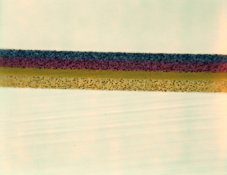Dave;
IDK about the developer, but the bleach is a process that goes to completion. If it does not work properly, the dmin values go up and become gray. Therefore, if the whites are white, silver is gone, bleaching worked as desired and something else is probably wrong. Of course, the catalyst in the bleach has some effect on dye contrast and intensity, but if it is at the wrong level, then all of the silver is not properly bleached.
It is probably either the paper or developer based on what I know of the chemistry of the process.
The developer must get good silver contrast and must produce some degree of interlayer effects to enhance color. The paper must have enough contrast in the emulsions and enough iodide in them to enforce this effect. If either one of these fail, then the process fails.
Too much silver, or overdevelopment for example will lower contrast, dmax and color saturation. A developer with low activity would do the same, but would leave a somewhat elevated dmin behind. So it looks like a low silver coating, or an overactive developer.
Of course, they may be using new dyes with lower purity. This would decrease the cost. They also might have reduced the level of the old dyes to reduce cost. Both moves would give a more muted color, but the latter method would also reduce the depth of blacks.
Just a bunch of guesses. I'm about to do some dye bleach experiments on my first steps to making a multilayer color print material as a test. So, I've been studying the chemistry again.
PE













 . I'm afraid DIY emulsion making and coating are all in the realm of magic to me so I've no idea what is and is not feasible - my A-Level Chemistry was a long time ago...
. I'm afraid DIY emulsion making and coating are all in the realm of magic to me so I've no idea what is and is not feasible - my A-Level Chemistry was a long time ago...